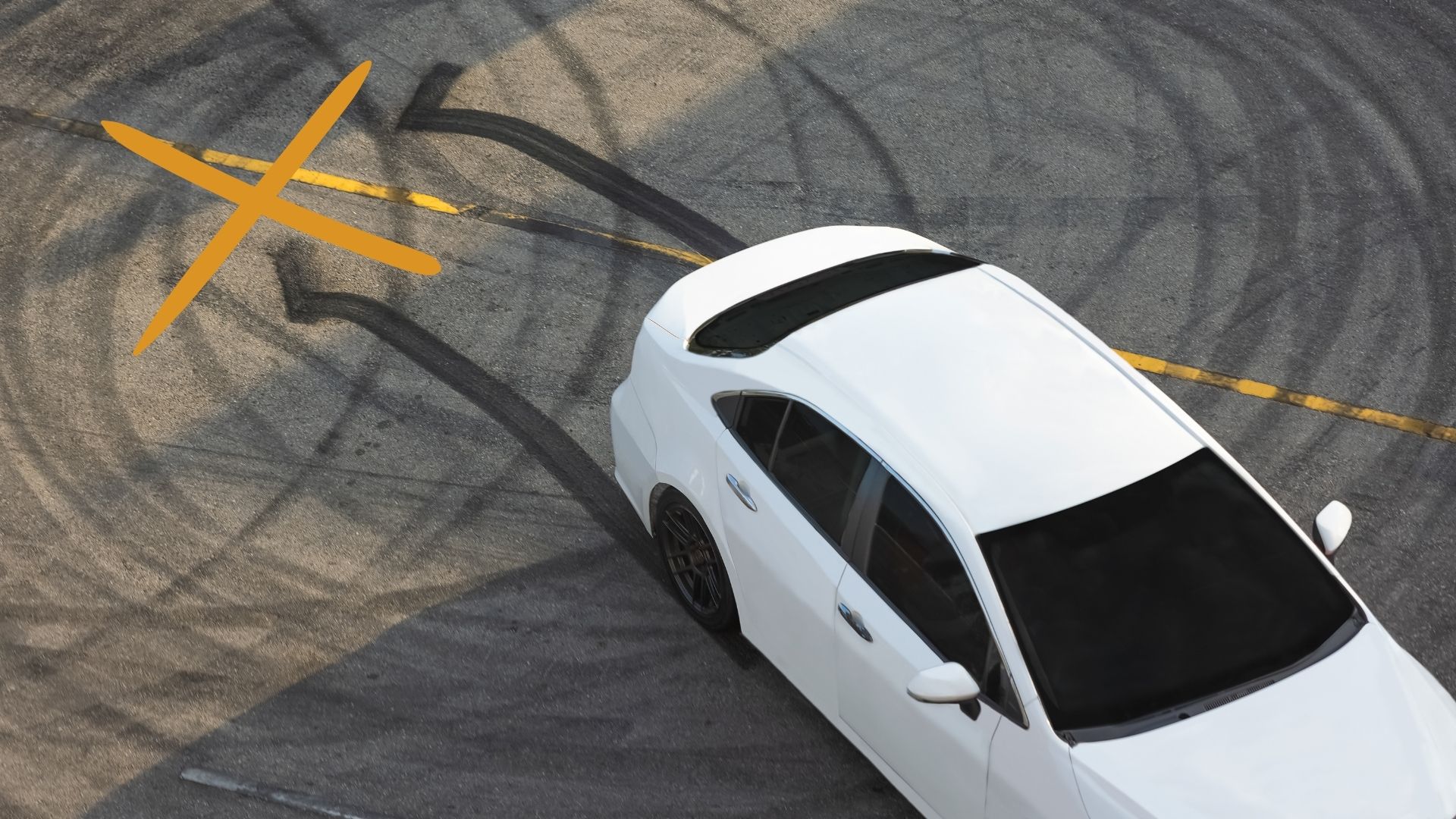The sad truth, is that some of our prospective clients come to our office charged with a burnout resulting from rather innocuous facts and not from what we traditionally believe to be the case of a burnout.
Burnout and loss of traction offences
The legislation governing the range of offences are essentially contained in s116 Road Transport Act 2013, which in summary states:
ROAD TRANSPORT ACT 2013 – SECT 116
116 Conduct associated with road and drag racing and other activities
(1) A person must not operate a motor vehicle on a road in such a manner as to cause the vehicle to undergo sustained loss of traction by one or more of the driving wheels (or, in the case of a motor cycle, the driving wheel) of the vehicle.
(2) A person must not:
(a) operate a motor vehicle contrary to subsection (1) knowing that any petrol, oil, diesel fuel or other inflammable liquid has been placed on the surface of the road beneath one or more tyres of the vehicle, or
(b) do, or omit to do, any other thing that prolongs, sustains, intensifies or increases loss of traction as referred to in subsection (1), or
(c) repeatedly operate a motor vehicle contrary to subsection (1), or
(d) operate a motor vehicle contrary to subsection (1) at a time, or on a road in a place, knowing that there is an appreciable risk that operation of the vehicle in that manner at that time and place is likely to interfere with the amenity of the locality or the peaceful enjoyment of any person in the locality or make the place unsafe for any person in the locality, or
(e) willingly participate in any group activity involving the operation of one or more vehicles contrary to subsection (1), or
(f) organise, promote or urge any person to participate in, or view, any group activity involving the operation of one or more vehicles contrary to subsection (1), or
(g) photograph or film a motor vehicle being operated contrary to subsection (1) for the purpose of organising or promoting the participation of persons in any such group activity.
(3) It is a defence to a prosecution for an offence against subsection (1) or (2) if the defendant proves to the court’s satisfaction that the vehicle, although operated as referred to in subsection (1), was not so operated deliberately.
…
(6) In considering whether an offence has been committed under subsection (2) (d), the court is to have regard to all the circumstances of the case, including the following:
(a) the nature and use of the road on which the offence is alleged to have been committed,
(b) the nature and use of any premises in the locality of the road in which the offence is alleged to have been committed.
Case Study
Even though more likely to be a charge relating to cars the facts as in this case can equally be applied to a bike if an over zealous highway patrol officer were to get on your case. Specially when one remembers the type of sports/race tyres, which can be fitted onto, sports bikes.
The key components of this offence are a deliberate sustained loss of traction. Of equal concern are the more serious offences created by subsection 2 in operating a vehicle contrary to subsection 1 with certain materials applied to the road surface, or interfering with amenity of the neighbourhood, or organising or promoting it, or filming or taking photographs of the activity for the purposes of promotion of the activity. If you are charged with the offence pursuant to subsection 1, the maximum penalty is a fine of 10 penalty units. If you are charged with the more serious offence under subsection 2, the maximum penalty available to the Court will depend on whether this is a first or second and subsequent offence. In the case of a first offence, the maximum penalty is 30 penalty units. In the case of a second or subsequent offence, the maximum penalty is a fine of 30 penalty units and/or a period of imprisonment for nine (9) months.
Furthermore, on conviction for an offence under subsection 2 (that is, points a to d of subsection 2) where you are the driver of the vehicle, a disqualification period of 12 months will be imposed or if the court sees fit a greater or lesser period.
ROAD TRANSPORT (SAFETY AND TRAFFIC MANAGEMENT) ACT 1999 – SECT 41
41 Conduct associated with road and drag racing and other activities
(cf Traffic Act, s 4BA)
(1) A person must not, on a road or road related area, operate a motor vehicle in such a manner as to cause the vehicle to undergo sustained loss of traction by one or more of the driving wheels (or, in the case of a motor cycle, the driving wheel) of the vehicle.
Maximum penalty: 10 penalty units.
(2) A person must not:
(a) operate a motor vehicle contrary to subsection (1) knowing that any petrol, oil, diesel fuel or other inflammable liquid has been placed on the surface of the road or road related area beneath one or more tyres of the vehicle, or
(b) do, or omit to do, any other thing that prolongs, sustains, intensifies or increases loss of traction as referred to in subsection (1), or
(c) repeatedly operate a motor vehicle contrary to subsection (1), or
(d) operate a motor vehicle contrary to subsection (1) at a time, or on a road or road related area in a place, knowing that there is an appreciable risk that operation of the vehicle in that manner at that time and place is likely to interfere with the amenity of the locality or the peaceful enjoyment of any person in the locality or make the place unsafe for any person in the locality, or
(e) willingly participate in any group activity involving the operation of one or more vehicles contrary to subsection (1), or
(f) organise, promote or urge any person to participate in, or view, any group activity involving the operation of one or more vehicles contrary to subsection (1), or
(g) photograph or film a motor vehicle being operated contrary to subsection (1) for the purpose of organising or promoting the participation of persons in any such group activity.
Maximum penalty: 30 penalty units (in the case of a first offence) or 30 penalty units or imprisonment for 9 months or both (in the case of a second or subsequent offence).
(3) In any proceedings for an offence under subsection (1) or (2), it is a defence if the person charged satisfies the court that the vehicle, although operated as referred to in subsection (1), was not so operated deliberately.
(4) A person must not, on a road or road related area, engage in conduct prescribed by regulations made for the purposes of this section, being conduct associated with the operation of a motor vehicle for speed competitions or other activities specified or described in the regulations.
Maximum penalty: 5 penalty units.
(5) Nothing in this section applies to the operation of a motor vehicle for the purposes of a race, attempt or trial undertaken in accordance with an approval given under section 40 by the Commissioner of Police.
(6) In considering whether an offence has been committed under subsection (2) (d), the court is to have regard to all the circumstances of the case, including the following:
(a) the nature and use of the road or road related area in which the offence is alleged to have been committed,
(b) the nature and use of any premises in the locality of the road or road related area in which the offence is alleged to have been committed.
(7) A person who is convicted by a court of an offence under subsection (2) (a), (b), (c) or (d) in relation to a motor vehicle is disqualified from holding a driver licence by the conviction and without any specific order of the court for 12 months.
(8) Any disqualification under this section is in addition to any penalty imposed for the offence.
ROAD TRANSPORT (GENERAL) ACT 2005 – SECT 217A
217A Definitions
…..
“sanctionable offence” means any of the following:
(a) a high range speed offence,
(b) an offence under section 40 or 41 (2) of the Road Transport (Safety and Traffic Management) Act 1999 ,
(c) an offence under section 51B (Police pursuits) of the Crimes Act 1900 ,
(d) any other offence prescribed by the regulations.
ROAD TRANSPORT (GENERAL) ACT 2005 – SECT 218
218 When additional sanctions may be imposed
A police officer may impose any one or more of the sanctions set out in section 218A if the police officer reasonably believes that a motor vehicle:
(a) is being or has (on that day or during the past 10 days) been operated on a road by an offending operator of the vehicle so as to commit a sanctionable offence, or
(b) is being or has (on that day or during the past 10 days) been operated on a road by a driver (whether or not an offending operator of the motor vehicle) during a number plate confiscation period, or
(c) is being or has (on that day or during the past 10 days) been operated on a road by an offending operator of the vehicle who has committed an offence under section 218E (Failure to comply with production notice), or
(d) is being operated on a road by a person who has been charged with an offence under section 218F (Number plate and other offences), or
(e) is the subject of forfeiture under section 219.
ROAD TRANSPORT (GENERAL) ACT 2005 – SECT 218A
218A Sanctions that may be imposed
(1) The police officer may do any one or more of the following:
(a) seize and take charge of the motor vehicle and cause it to be moved to a place determined by the Commissioner,
(b) immediately, or as soon as practicable afterwards, give or send the offending operator a notice (a “motor vehicle production notice”) requiring the offending operator to move or cause the vehicle to be moved to, or to produce or cause to be produced to a police officer at, a place specified in the notice no later than on the date and time specified in the notice (the “motor vehicle production date”),
(c) remove and confiscate the number plates affixed to the motor vehicle and attach a number plate confiscation notice to the motor vehicle,
(d) immediately or as soon as practicable afterwards:
(i) give the offending operator a notice (a “number plate production notice”) requiring the offending operator to remove or cause to be removed the number plates affixed to the vehicle and produce them to a police officer at a place specified in the notice no later than on the date and time specified in the notice (the “number plate production date”), and
(ii) attach a number plate confiscation notice to the motor vehicle,
(e) as soon as practicable afterwards, send to the offending operator at the garage address of the motor vehicle:
(i) a notice (a “number plate production notice”) requiring the offending operator to remove or cause to be removed the number plates affixed to the vehicle and produce them to a police officer at a place specified in the notice no later than on the date and time specified in the notice (the “number plate production date”), and
(ii) a number plate confiscation notice.
(2) An offending operator who is sent a number plate confiscation notice under subsection (1) (e) must attach the number plate confiscation notice to the motor vehicle in the manner described on the notice no later than on the number plate production date.
Maximum penalty: 30 penalty units.
(3) Except as provided by this Division, a motor vehicle to which a number plate confiscation notice is attached under:
(a) subsection (1) (c) is prohibited from being operated on any road during the period of 3 months commencing on the day the notice is attached to the vehicle, and
(b) subsection (1) (d) or (e) is prohibited from being operated on any road during the period of 3 months commencing from the number plate production date.
Note: See section 218F with respect to number plate offences.
ROAD TRANSPORT (GENERAL) ACT 2005 – SECT 218D
218D Removal, impounding and production of vehicle
(1) Any motor vehicle moved to, or produced at, a place in accordance with section 218A may, subject to the regulations, be impounded by the Commissioner at that place or may be moved to and impounded at any other place determined by the Commissioner.
(2) A certificate in writing given by a police officer as to the fact and cost of any such movement is evidence of those matters.
ROAD TRANSPORT (GENERAL) ACT 2005 – SECT 219
219 Forfeiture of vehicles on finding of guilt of offending operator
(1) A motor vehicle used in connection with a sanctionable offence that is a second or subsequent offence by the offending operator under the provision concerned within a 5 year period is, by the finding of guilt by the court, forfeited to the Crown unless already forfeited under section 218E or the court otherwise directs under section 219A.
Note: A forfeited motor vehicle may be crash tested-see section 225 (6).
(2) A motor vehicle used in connection with an offence under section 218F (a “number plate offence”) is, by the finding of guilt by the court, forfeited to the Crown unless already forfeited under section 218E or the court otherwise directs under section 219A.
Note: A forfeited motor vehicle may be crash tested-see section 225 (6).
(3) Any forfeiture under this section is in addition to any other penalty that may be imposed for the offence concerned, but for the purposes of any rights of appeal against a penalty so imposed by the court finding the offence to be proven, the forfeiture is taken to be, or to be part of, that penalty.
(4) For the purposes of this section, payment of the amount specified in a penalty notice issued in respect of a sanctionable offence or a number plate offence, or in any process issued subsequent to such a penalty notice, as the amount that is payable in order to dispose of the alleged offence without having it dealt with by a court has the same effect as a finding by a court that the offence was proven.
ROAD TRANSPORT (GENERAL) ACT 2005 – SECT 219A
219A Commutation of forfeiture
(1) The court that finds a person guilty of an offence referred to in section 218E (5) or 219 (2) may, at the time of making that finding, by order direct that the forfeiture that would otherwise be imposed under the provision concerned by that finding be commuted to a period of impounding, or confiscation of number plates, specified in the order, if the court is satisfied that the forfeiture of the motor vehicle will cause extreme hardship to the offending operator or any other person (emphasis is mine).
(2) For the purposes of subsection (1), financial loss or difficulty in carrying out employment (whether paid or unpaid) or in travelling to a place of employment or business or to any place for the purposes of education, training or study does not constitute extreme hardship.
ROAD TRANSPORT (GENERAL) ACT 2005 – SECT 221
221 Retention of motor vehicle impounded or number plates confiscated under this Division
(1) The Commissioner is to retain a motor vehicle impounded under section 218D for the period of 3 months after its impoundment, unless it is sooner released under this Division or in accordance with the regulations (emphasis is mine).
(2) The Authority is to retain number plates confiscated under section 218A for the period of 3 months after they are confiscated, unless they are sooner released under this Division or in accordance with the regulations.
(3) This section does not apply in the case of a motor vehicle impounded in the circumstances referred to in section 218 (e), except as prescribed by the regulations.
(3) The period for which a motor vehicle was impounded under section 218D is to be reckoned as counting towards a period of impounding imposed under this section.
(4) A motor vehicle impounded by an order of a court under this section is to be retained by the Commissioner for the time required by the order, unless it is sooner released under this Division.
(5) Number plates confiscated by an order of a court under this section are to be retained by the Authority for the time required by the order, unless they are sooner released under this Division.
ROAD TRANSPORT (GENERAL) ACT 2005 – SECT 222
222 Early release of motor vehicle and number plates on application to Local Court
(1) A person may apply to the Local Court for an order for the release into the person’s custody of:
(a) a motor vehicle impounded under this Division before the end of the period of impounding imposed on the motor vehicle, or
(b) number plates confiscated under this Division before the end of the number plate confiscation period applying to the number plates.
(2) An order cannot provide for release on a day that is less than 5 working days after the vehicle was impounded or the number plates were confiscated.
(3) In determining whether to make an order under this section, the Local Court is entitled to have regard to the following:
(a) the safety of the public and the public interest in preventing the use of a motor vehicle that the Court considers is reasonably likely in all the circumstances to be used for further sanctionable offences,
(b) any alleged extreme hardship to a person other than the registered operator of the motor vehicle arising from the impoundment of the vehicle or confiscation of the number plates.
(4) The motor vehicle or number plates are to be released by order of the Local Court only after the applicant has paid in full any applicable movement, towing and storage fees under section 223.
(5) An applicant into whose custody a motor vehicle is released by an order under this section must acknowledge in writing receipt of the motor vehicle from the custody of the Commissioner.
(6) An applicant into whose custody number plates are released by an order under this section must acknowledge in writing receipt of the number plates from the custody of the Authority.
(7) An applicant into whose custody number plates are released by an order under this section must remove any number plate confiscation notice attached to the motor vehicle before the motor vehicle is operated on any road.
***************************

 (02) 8806 0866
(02) 8806 0866


